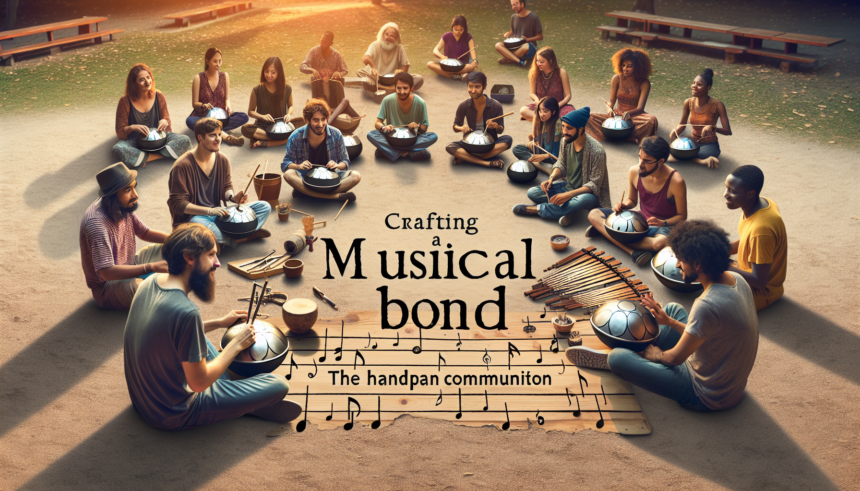<!DOCTYPE html>
<html lang="en">
<head>
<meta charset="UTF-8">
<meta name="viewport" content="width=device-width, initial-scale=1.0">
<title>Crafting a Musical Bond: The Handpan Community's Evolution</title>
<style>
body {
font-family: Arial, sans-serif;
line-height: 1.6;
margin: 20px;
color: #333;
}
h2 {
color: #555;
}
ul {
list-style-type: square;
margin-left: 20px;
}
</style>
</head>
<body>
<h2>Introduction</h2>
<p>The rich, resonant tones of the handpan have captivated listeners across the globe, weaving a tapestry of connection among musicians and enthusiasts alike. This unconventional percussive instrument, with its celestial soundscape, serves not only as a musical marvel but also as a beacon around which a thriving community has evolved. The journey of the handpan community's evolution is a testament to the power of music in fostering unity, creativity, and a sense of belonging.</p>
<h2>The Birth of the Handpan</h2>
<p>The handpan, an instrument that has only been around since the turn of the 21st century, has a singular origin story. It was first created in Switzerland by Felix Rohner and Sabina Schärer, founders of PANArt, who sought to combine the Caribbean steelpan's percussive qualities with the compact and versatile design of the ghatam and the Hang. The instrument quickly gained notoriety for its unique ability to produce a wide range of tones in a meditative, almost hypnotic manner.</p>
<h2>Initial Growth and Spread</h2>
<p>As word of the handpan's enchanting sound spread, musicians from diverse backgrounds were drawn to its melodic magic. Initially, obtaining a handpan was challenging due to limited production, which only fueled the intrigue and exclusivity around it. Early adopters included street performers, new age musicians, and percussion enthusiasts who were eager to explore something different. Social media and platforms such as YouTube played a crucial role in showcasing handpan performances, facilitating its spread beyond European borders.</p>
<h2>Community Building and Sharing</h2>
<p>The handpan community's evolution was remarkably organic. Despite its niche status, the communal spirit flourished in various online forums, such as dedicated Facebook groups and niche websites. These platforms became safe havens for enthusiasts where ideas, music, and passions were freely exchanged. Additionally, the annual gatherings and workshops that emerged around the world provided physical spaces for this community to come together and share their experiences and skills.</p>
<h2>A Symposium of Sounds: Festivals and Gatherings</h2>
<p>From the idyllic settings of European countryside retreats to mesmerizing beaches in South America, handpan festivals and gatherings have become crucial to the community's growth. Events like the HangOut UK, Handpan Festival France, and Pantasia have become annual pilgrimages for enthusiasts. These gatherings serve not just as festivals but as collaborative melting pots where anyone from master craftsmen to budding enthusiasts can exchange ideas, techniques, and performances. The mutual respect and admiration found in these events empower participants and strengthen the bonds within this niche community.</p>
<h2>Technological Advancements and Innovations</h2>
<p>As the handpan community expanded, so did the creativity surrounding its make and use. New makers emerged, each bringing their spin to the instrument, experimenting with different materials, sizes, and structures. This variety enriched the musical possibilities and expanded the community by making the handpan more accessible. Additionally, the advent of digital music technology allowed for a fusion of traditional handpan sounds with electronic music, inviting a broader spectrum of musicians to explore its potential.</p>
<h2>The Handpan as a Tool for Healing and Meditation</h2>
<p>Beyond just musical expression, the handpan has found a significant place in the world of therapy and wellness. Its tranquil and soothing tones have been embraced by practitioners of yoga, meditation, and sound therapy. The community surrounding the handpan often shares stories of personal transformation, where the instrument's music aids in achieving mental clarity, emotional release, and spiritual growth. This shared appreciation for the handpan's healing properties has further fortified communal ties.</p>
<h2>Global Influence and Cultural Integration</h2>
<p>The handpan's rise to prominence is a story of cultural confluence. As the instrument traveled across continents, it absorbed influences from various musical traditions. Artists from different cultures began to infuse their regional sounds and techniques with handpan performances, creating a fusion that's as diverse as the community itself. This blending of cultures resulted in a richer global tapestry of music, further propagated through collaborations and projects that spanned countries and continents.</p>
<h2>Challenges and Preservation of the Art</h2>
<p>Despite its growth and vibrant community, the handpan world faces challenges, particularly concerning the preservation of quality and craftsmanship. The community has taken strides to ensure that new makers adhere to high standards, establishing a balance between innovation and tradition. Organizations and guilds have been formed to safeguard the legacy of the handpan and mentor up-and-coming craftsmen to uphold the values instilled by the instrument's pioneers.</p>
<h2>Conclusion</h2>
<p>The handpan community's evolution exhibits the profound impact a musical instrument can have beyond its sound. It has grown into a global movement where individuals convene, not just in admiration of the music but in a common pursuit of harmony, creativity, and camaraderie. The beauty of the handpan lies not only in its celestial tones but also in its unique ability to bridge cultural divides, provide therapeutic benefits, and foster an ever-expanding circle of inspired individuals around the planet.</p>
<h2>FAQs</h2>
<ul>
<li>
<strong>What is a handpan?</strong>
<p>The handpan is a percussive musical instrument resembling a UFO-shaped metal drum that produces melodious and resonant sounds. It's played by striking or gliding the hand across its surface, producing tones with unique timbres.</p>
</li>
<li>
<strong>How was the handpan created?</strong>
<p>The handpan was developed by Swiss inventors Felix Rohner and Sabina Schärer in the year 2000. The instrument was designed by bringing together elements from the Caribbean steelpan and the Indian ghatam, resulting in a compact and versatile piece.</p>
</li>
<li>
<strong>What are the benefits of playing the handpan?</strong>
<p>Playing the handpan can have numerous benefits, including stress reduction, improved focus, and a sense of emotional and spiritual well-being. Its soothing sounds make it an ideal instrument for meditation and therapeutic practices.</p>
</li>
<li>
<strong>Are there handpan communities worldwide?</strong>
<p>Yes, there are vibrant handpan communities scattered across the globe. Enthusiasts engage through online forums, social media groups, and physical gatherings and festivals dedicated to celebrating and sharing the art of the handpan.</p>
</li>
<li>
<strong>How can I learn to play the handpan?</strong>
<p>There are several resources available for learning to play the handpan, including online tutorials, workshops, and classes. Many experienced players offer video guides and personal lessons to help newcomers develop their skills.</p>
</li>
</ul>
</body>
</html>Crafting a Musical Bond: The Handpan Community’s Evolution

Leave a comment




